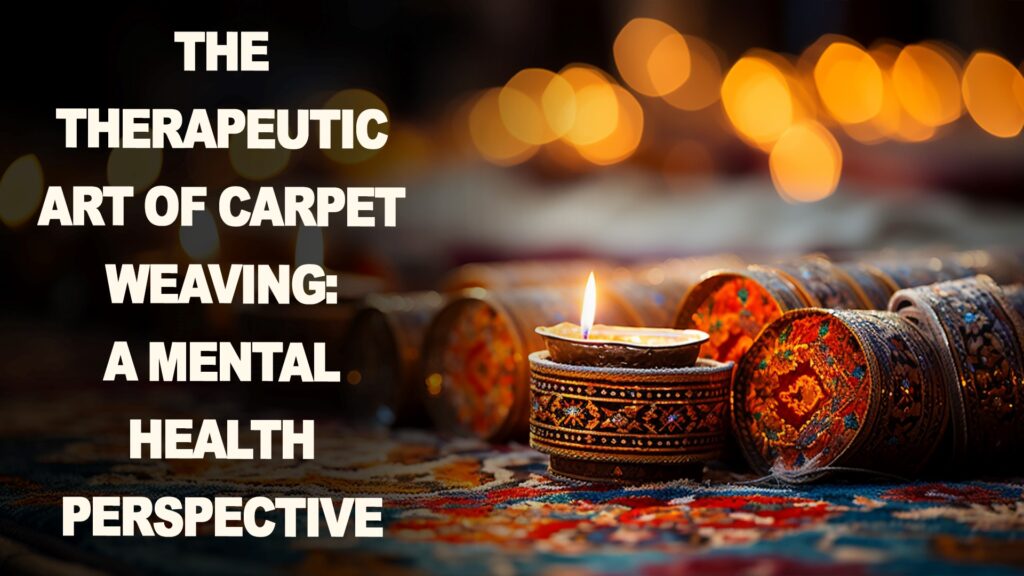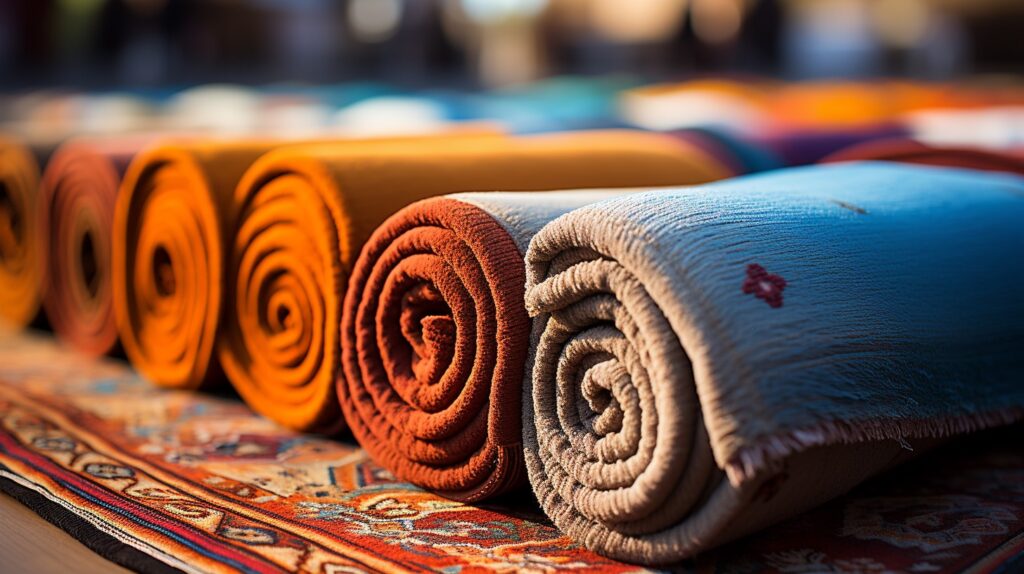
Introduction to Carpet Weaving and Mental Health
The intricate art of carpet weaving holds a storied place in the tapestry of human culture. For centuries, carpet weaving has been more than just a craft; it’s a narrative of life, history, and personal expression. While aesthetically magnificent, carpet weaving also possesses profound psychological and therapeutic properties, often overlooked in modern discourse.
Carpets have often been physical manifestations of the environment and the inner workings of the mind. The complex patterns and the rhythm of the loom bring forth a therapeutic calmness, helping weavers navigate the labyrinth of their thoughts and emotions. Historically, the art has served as a meditative practice, and today it has the potential to contribute significantly to the field of mental health.
Understanding the connection between mind and hand is fundamental to grasping the therapeutic potential of weaving. The coordination required to weave intricate patterns on a loom demands focus and precision, creating a mindful state that allows for a reprieve from stress and anxiety. This phenomenon can be a gateway to exploring broader mental health benefits.
Handicrafts like carpet weaving involve a deeply personal connection between the creator and their work, promoting a sense of fulfillment and accomplishment. Crafting something tangible provides immediate feedback, a sensory experience often missing in today’s digital world, and one that can have positive implications for one’s mental well-being.
Psychological Aspects of Weaving
Delving into the psychological layers of weaving, one finds a rich blend of mental stimuli. Weaving can induce what psychologist Mihaly Csikszentmihalyi refers to as a ‘flow’ state – a zone of complete immersion where time seems to vanish, and the weaver is absorbed in the moment. This state of flow has been linked with improved mental health, offering a respite from the ceaseless pace of contemporary life.
The colors chosen for a carpet often have deeper psychological implications. Color therapy, or chromotherapy, is an area of holistic healing that uses the visual spectrum of colors to heal the mind and body. Weavers intuitively employ this therapy, selecting colors that not only appeal aesthetically but also resonate emotionally and spiritually.
Symmetry and pattern in weaving contribute to a sense of order and balance, which can be particularly soothing for individuals dealing with mental health issues like anxiety or depression. The predictability and repetition inherent in weaving patterns provide a structured outlet for chaotic feelings, a way to organize the turmoil within the mind’s eye.Emotional Healing Through Weaving

Carpet weaving allows for storytelling without words. Each knot and color choice is a lexicon in the language of the weaver, offering a unique opportunity for self-expression and emotional release. For those struggling to articulate their feelings, the act of weaving can become a voice for unspoken trauma or joy.
Many who engage in weaving after traumatic experiences find it a helpful mechanism for coping. The repetitive motion of the loom acts as a form of rhythmic therapy, allowing for the expression of pain in a controlled and non-verbal way. This process can be integral to healing, providing a means to process and compartmentalize overwhelming emotions.
In the creation of something beautiful from mere threads, weavers find a powerful sense of achievement. The completion of a carpet is a testament to patience and skill, engendering pride and boosting self-esteem. For individuals with mental health struggles, such accomplishments can be incredibly affirming and empowering.
Social and Cultural Dimensions of Weaving
Carpet weaving has traditionally been a communal activity. In many cultures, it is a conduit for social connection, bringing together individuals of varied ages and backgrounds to engage in a shared purpose. This collective aspect of weaving is significant in combating loneliness and fostering a sense of belonging, both of which are critical for mental health.
Weaving is also a means of cultural and historical storytelling, a living heritage passed down through generations. For many weavers, their craft is intrinsically tied to their identity and sense of self. Engaging in this traditional art form can thus serve as an anchor, providing stability and continuity that bolsters mental health.
The role of carpet weaving in cultural resilience cannot be understated. Communities that have faced upheaval, displacement, or trauma often turn to traditional crafts as a means of preserving their identity and coping with change. The act of weaving can become a symbol of strength and a tool for mental survival.
Cognitive Benefits and Skill Development
Engaging in carpet weaving not only has emotional and social benefits but also cognitive ones. The art of weaving demands attention to detail, planning, and problem-solving, all of which keep the mind sharp and active. As weavers plan their designs, they are activating the frontal lobes of the brain, responsible for executive functions such as decision-making and planning.
Memory enhancement is another cognitive benefit associated with weaving. The need to remember patterns and sequences in weaving can improve both short and long-term memory. For older adults, in particular, weaving can serve as a cognitive exercise to maintain mental acuity and slow the progression of memory-related diseases.
The skills learned through weaving go beyond the loom. The discipline and focus required to weave can be transferred to other areas of life, encouraging a more organized approach to daily tasks and challenges. For children and adults with attention-deficit disorders, the structured nature of weaving can help in developing a more focused and sustained attention span.
Therapeutic Weaving in Modern Healthcare
The integration of weaving into modern therapeutic practices is gaining ground. Art therapy, a field that uses the creative process of making art to improve a person’s physical, mental, and emotional well-being, now often includes textile arts like weaving. Patients with various conditions, from dementia to depression, are encouraged to weave as a form of expression and healing.
Hospitals and clinics are beginning to recognize the calming effect of weaving on patients. Waiting areas equipped with small weaving looms provide a distraction from anxiety-inducing environments, allowing patients to engage in a soothing activity while waiting for treatment or results.
Occupational therapists use carpet weaving as a rehabilitation activity to help patients recover from physical injuries. The act of weaving can aid in regaining dexterity and hand-eye coordination. Furthermore, the creative aspect of weaving aids in psychological rehabilitation, giving patients a sense of purpose and achievement.
Challenges and Considerations in Therapeutic Weaving
Despite its benefits, the therapeutic application of carpet weaving is not without its challenges. Accessibility to materials and resources can be a barrier. High-quality looms and yarns can be expensive and may not be available to all who could benefit from weaving therapy.
Instructors trained in the nuances of therapeutic weaving are crucial to its success. They must be adept not only in weaving techniques but also in understanding the therapeutic needs of diverse populations. The lack of such trained professionals can limit the reach of weaving as a form of therapy.
There is also the risk of commodification, where the focus shifts from the process to the end product, potentially adding pressure and detracting from the therapeutic experience. Therapeutic programs need to emphasize the creative process and personal growth over the commercial value of the finished carpet.Future Directions in Weaving and Mental Health

The future of carpet weaving in the realm of mental health is promising. With an increasing body of research supporting its benefits, weaving is poised to become a staple in holistic therapeutic practices. As society becomes more aware of the importance of mental health, traditional crafts like weaving are regaining value as effective complementary treatments.
Technological advancements are creating new opportunities for weaving therapy. Virtual reality and online platforms can make weaving more accessible, allowing people to engage in the therapeutic process from their own homes. Such technologies could bring the benefits of weaving to a wider audience, including those who are physically unable to attend traditional weaving workshops.
Continued interdisciplinary research involving psychologists, occupational therapists, and weaving artisans is crucial. Collaborations like these will deepen our understanding of the therapeutic aspects of weaving and refine methods to maximize its mental health benefits.
Conclusion
The intricate threads of carpet weaving are interwoven with the threads of human psychology, offering a rich landscape for therapeutic exploration. From the rhythmic motions to the colorful patterns, every aspect of weaving is a dance of the cognitive, emotional, and social elements of the human experience. Recognizing and harnessing this ancient art form in the context of mental health opens up a world of possibilities for healing, resilience, and growth. As the world embraces a more holistic approach to health and wellness, carpet weaving stands as a testament to the enduring power of traditional crafts in nurturing not just the body, but also the mind and soul.